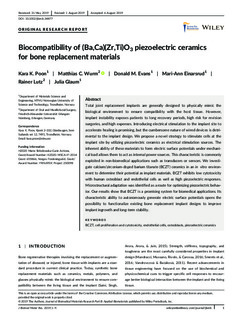| dc.contributor.author | Poon, Kara | |
| dc.contributor.author | Wurm, Matthias C. | |
| dc.contributor.author | Evans, Donald | |
| dc.contributor.author | Einarsrud, Mari-Ann | |
| dc.contributor.author | Lutz, Rainer | |
| dc.contributor.author | Glaum, Julia | |
| dc.date.accessioned | 2020-01-06T07:58:54Z | |
| dc.date.available | 2020-01-06T07:58:54Z | |
| dc.date.created | 2019-09-26T16:22:01Z | |
| dc.date.issued | 2019 | |
| dc.identifier.citation | Journal of Biomedical Materials Research. Part B - Applied biomaterials. 2019, 1-9. | nb_NO |
| dc.identifier.issn | 1552-4973 | |
| dc.identifier.uri | http://hdl.handle.net/11250/2634894 | |
| dc.description.abstract | Total joint replacement implants are generally designed to physically mimic the biological environment to ensure compatibility with the host tissue. However, implant instability exposes patients to long recovery periods, high risk for revision surgeries, and high expenses. Introducing electrical stimulation to the implant site to accelerate healing is promising, but the cumbersome nature of wired devices is detrimental to the implant design. We propose a novel strategy to stimulate cells at the implant site by utilizing piezoelectric ceramics as electrical stimulation sources. The inherent ability of these materials to form electric surface potentials under mechanical load allows them to act as internal power sources. This characteristic is commonly exploited in non‐biomedical applications such as transducers or sensors. We investigate calcium/zirconium‐doped barium titanate (BCZT) ceramics in an in vitro environment to determine their potential as implant materials. BCZT exhibits low cytotoxicity with human osteoblast and endothelial cells as well as high piezoelectric responses. Microstructural adaptation was identified as a route for optimizing piezoelectric behavior. Our results show that BCZT is a promising system for biomedical applications. Its characteristic ability to autonomously generate electric surface potentials opens the possibility to functionalize existing bone replacement implant designs to improve implant ingrowth and long‐term stability. | nb_NO |
| dc.language.iso | eng | nb_NO |
| dc.publisher | Wiley Periodicals Inc. | nb_NO |
| dc.rights | Navngivelse 4.0 Internasjonal | * |
| dc.rights.uri | http://creativecommons.org/licenses/by/4.0/deed.no | * |
| dc.title | Biocompatibility of (Ba,Ca)(Zr,Ti)O3 piezoelectric ceramics for bone replacement materials | nb_NO |
| dc.type | Journal article | nb_NO |
| dc.type | Peer reviewed | nb_NO |
| dc.description.version | publishedVersion | nb_NO |
| dc.source.pagenumber | 1-9 | nb_NO |
| dc.source.journal | Journal of Biomedical Materials Research. Part B - Applied biomaterials | nb_NO |
| dc.identifier.doi | 10.1002/jbm.b.34477 | |
| dc.identifier.cristin | 1729783 | |
| dc.description.localcode | © 2019 The Authors. Journal of Biomedical Materials Research Part B: Applied Biomaterials published by Wiley Periodicals, Inc. This is an open access article under the terms of the Creative Commons Attribution License, which permits use, distribution and reproduction in any medium, provided the original work is properly cited. | nb_NO |
| cristin.unitcode | 194,66,35,0 | |
| cristin.unitname | Institutt for materialteknologi | |
| cristin.ispublished | true | |
| cristin.fulltext | postprint | |
| cristin.qualitycode | 1 | |

